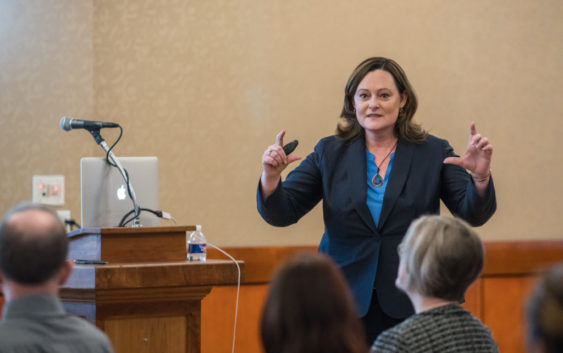- Western NC wildfire risk will 'get worse, not better' Ag Commissioner says, pressing lawmakers for help
- Watering trees is a must to protect them from severe weather and drought
- At least 4 dead, hundreds rescued after deadly floods ravage South Texas
- Today on Texas Standard: Deadly floods swamp South Texas, shatter records
- North Carolina radio station was a critical lifeline after Hurricane Helene. Then it became the voice of recovery.
Hurricane Harvey Researcher Brings Disaster Response on Social Media to Ted Talk

In disasters, the official emergency procedure is to call 911. But during Hurricane Harvey last year, many people posted calls for help on social media instead — a phenomenon that University of Texas at Austin professor Keri Stephens decided to study.
Stephens, who teaches communications studies at UT Austin, will be presenting her research at TEDxPalo Alto College, a TED Talk event hosted at the South San Antonio community college on Saturday. Thanks to a National Science Foundation grant, Stephens and her team interviewed people who asked for help through social media during Hurricane Harvey, people who answered those calls for help, and official responders.
At Saturday’s TED event, Stephens will explain how she gathered interviews and data. A flood survivor herself in elementary school, she noted the coincidence of her presentation and Hurricane Florence, which made landfall on Friday.
“Some of the things I say in my TED Talk are things I really do hope people thought about before this latest one hits,” she said. “We need to be thinking about communication and how citizens are going to communicate with official responders before these disasters hit.”
From her research, Stephens said one of the biggest issues she identified was a lack of resources to handle social media requests for help despite the fact people continue to use Twitter or Facebook instead of calling 911. Stephens noted that instead of only funding infrastructure projects, cities and counties need to address disaster communication.
“Citizens aren’t going to change their behaviors,” Stephens said.
Not all of Stephens’ research found communication missteps. There were a few success stories in her research. Stephens discovered a public information officer who tapped a volunteer to help triage social media posts.
“They worked together through Hurricane Harvey and it’s incredible how well it worked for him,” Stephens said. “I know [success] is possible because I have examples in the dataset where average citizens and responders work together and do a great job.”
She added that translation strategies in disaster response often falls short as well, because hiring translators costs money.
“Let’s assume you’re a small county and you need to respond to people’s questions,” she said. “The likelihood of having someone on staff who speaks Spanish is small even in a state [with so many Spanish speakers.]”
She hopes people will work together to fix that communication gap.
“San Antonio is so multicultural that I think they embrace that,” Stephen said. “That’s probably one of the reasons I’m most excited about being there because I think they’ll get that and they’ll really care.”
She has spoken with officials from Houston about disaster preparedness and communication but wants to keep the conversation going with other cities in Texas.
“I’m hoping this [talk] will open the door,” she said. “I don’t know people in San Antonio, but I would love to meet with people in San Antonio to see if the stuff I know can be helpful to them.”